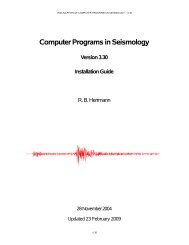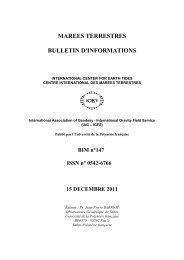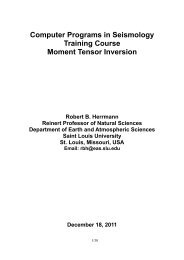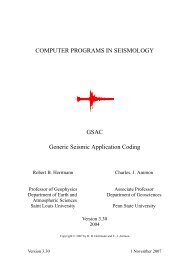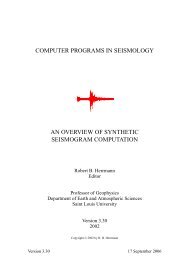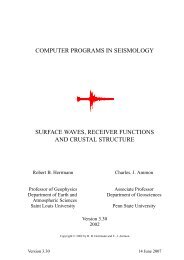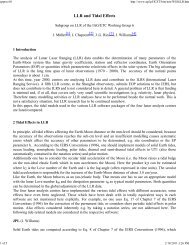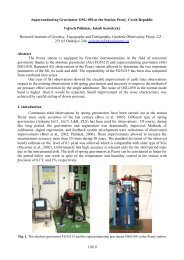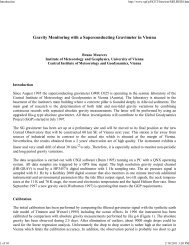3.04 Gravimetric Methods – Superconducting Gravity Meters
3.04 Gravimetric Methods – Superconducting Gravity Meters
3.04 Gravimetric Methods – Superconducting Gravity Meters
Create successful ePaper yourself
Turn your PDF publications into a flip-book with our unique Google optimized e-Paper software.
76 <strong>Superconducting</strong> <strong>Gravity</strong> <strong>Meters</strong><br />
As more users began to acquire SGs for a variety<br />
of purposes, it became standard practice to sample at<br />
high rate (1<strong>–</strong>10 s) the full signal (tides þ seismic frequencies).<br />
Nevertheless, it took some time for the<br />
gravimeter community to achieve the goal of a common<br />
set of standards for the acquisition and exchange<br />
of SG data. As part of this goal, GWR provided a<br />
replacement gravity card (GGP gravity card) with a<br />
filter designed for 1 s sampling and additional circuitry<br />
for measuring the phase response of the<br />
gravimeter system (GGP newsletters #2 and #3).<br />
The first GWR data acquisition system manufactured<br />
in 1995 used CSGI software running on a PC<br />
with a QNX operating system. Soon, however,<br />
uncertainty in the future of the QNX operating system<br />
and software maintenance convinced GWR to<br />
develop a Windows-based system. In 1999, GWR<br />
and BKG reported on an ambitious project to control<br />
the SG remotely (Warburton et al., 2000). The prototype<br />
Remote SG R038 has been operating at<br />
Concepción, Chile, since December 2002, and almost<br />
all goals for remote operation have since been implemented.<br />
In 2004, GWR decided that all new<br />
observatory SGs should be provided with a GWR<br />
data acquisition system with remote control capabilities.<br />
This is required not only to further standardize<br />
GGP data but also to enable GWR to remotely<br />
diagnose problems as they arise and to solve them<br />
without requiring travel to the site of operation.<br />
<strong>3.04</strong>.1.6 User Requirements<br />
<strong>3.04</strong>.1.6.1 Operation and maintenance<br />
The SG sensing unit contains only one moving<br />
mechanical part, the niobium sphere. It is therefore<br />
virtually free of any maintenance requirements, and<br />
this has been verified by field installations of 15 years.<br />
SG support equipment, however, does need periodic<br />
maintenance to assure proper operation and can fail<br />
unexpectedly as the result of a lightning strike or<br />
other natural catastrophes. Many of the major gaps<br />
in SG data have been caused by power supply failure<br />
during major storms, or failure of the data acquisition<br />
systems. Planning for failure of either electronics or<br />
refrigeration is necessary to minimize interruptions<br />
in long (decadal) gravity records. It is most important<br />
to keep the dewar at least partially filled with liquid<br />
helium so that the sensor and superconductors<br />
remain below 4.5 K. Upon complete helium loss, the<br />
sensor will start warming up to room temperature.<br />
Although no damage occurs to the sensor, it requires<br />
that the sphere be relevitated, which reactivates the<br />
initial drift discussed in Section <strong>3.04</strong>.1.4.1 In practice,<br />
therefore, operators are very careful to make sure the<br />
liquid helium volume is kept above a minimum level,<br />
so that in the case of a power or coldhead failure<br />
there is enough time to either transfer more liquid<br />
helium or to fix the source of the failure. With the<br />
coldhead off, the maximum hold time for a Compact<br />
Dewar is about 60 days. Prudently, most operators do<br />
not let the liquid He fall below about one-third full.<br />
Therefore, even under severe interruptions, such as<br />
the fire at Mt. Stromlo, Australia, in January 2003, the<br />
operator has at least 20 days to solve the resulting<br />
problems without warming the sensor up. It is also<br />
important to follow the manufacturers’ and GWR’s<br />
instructions for maintenance of the coldhead, compressor,<br />
and water chiller to prevent equipment<br />
failure. Many operators keep a backup refrigeration<br />
system available for immediate replacement.<br />
At most of the GGP stations, operators check<br />
weekly that the refrigeration system and data acquisition<br />
system are functioning properly and ensure<br />
general site integrity. When problems develop, they<br />
will be observed either in the support status variables<br />
that monitor operation of the support equipment<br />
(temperature control, tilt-leveling control, and the<br />
refrigeration system), or will cause an increase in<br />
the instrumental gravity noise. For example, refrigeration<br />
problems cause immediate increase in helium<br />
boil-off rate and warming of dewar neck thermometers.<br />
Ice buildup around the coldhead that<br />
touches the inside of the dewar neck will cause an<br />
immediate increase in noise observed through the<br />
mode filter and on the gravity residual. Problems<br />
with the leveling system will be observed on the tilt<br />
X and Y balance signals and as gravity noise on the<br />
mode filter and gravity residual.<br />
The new GWR data acquisition system (DDAS)<br />
allows the operator to monitor about 30 status variables<br />
remotely. In addition, alarm levels can be set to<br />
automatically generate warnings and alert the operator<br />
by e-mail to initiate investigation and repair.<br />
After collection and analysis of 1 month data, the<br />
operator can enter a calibration factor, tidal parameters,<br />
and barometric pressure admittance, and the<br />
DDAS will automatically generate a theoretical tide<br />
and display the gravity residual signal in real time.<br />
This allows visual examination of the gravity noise<br />
at the sub-mGal scale. Changes in noise level<br />
are immediately observable and with some experience<br />
can be identified as those of geophysical<br />
origin (atmosphere, ocean, or earthquakes) or due to<br />
possible equipment problems. In the latter case,




